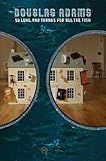Although auroras can appear in northern skies any time of year, they are more common and colorful in the colder months. The neon colors of northern lights are the result of radiation given off in the very high atmosphere by molecules that are energized by particles from the sun, or solar wind.
The solar wind is a constant, million-miles-an-hour hydrogen blast of energy made up of gas and electrically-charged particles from the surface of the sun. As this cloud of nitrogen ranges far into the solar system it becomes less dense.
When the particles reach the earth, our planet’s doughnut-shaped magnetic field funnels them toward the polar regions. There the gases of the earth’s atmosphere and the highly charged solar particles react causing the molecules to glow like the inside of a neon bulb.
The result are streamers or curtains of orange, pink, green, and lavender that can stretch from horizon to horizon. The most spectacular I’ve seen pulsated in waves across the night sky.
 True Midnight
True MidnightAuroras appear brightest in broad rings around the magnetic poles, usually at true midnight (half way between sunset and sunrise, not the time on the clock). In the southern hemisphere there are similar displays of southern lights called aurora australis.
The most brilliant auroras occur when there have been violent storms on the sun. Because it is impossible to know exactly when these sun storms will happen, there is no way to accurately predict northern lights very far in advance.
NASA and the University of Alaska post forecasts for northern lights one to two days ahead on worldwide web: at www.spaceweather.com.
 Sun Dogs
Sun DogsHave you ever looked towards the west on a winter afternoon and noticed colorful bars of light on one or both sides of the sun? These rainbow-type bars or stripes are parhelions, commonly called sun dogs or mock suns. “Par” is Greek for beside and “helius” is the Greek word for sun.
A parhelion is a bright vertical spot or bar on the luminous ring or halo that surrounds the sun. There are usually two spots, one on either side of the sun.
These spots occur at 22 degrees on the parhelic circle. Sometimes they are like a short piece of a rainbow with oranges, reds, yellows, and even greens. They are caused by the sun’s rays reflecting off atmospheric ice crystals. This means that there has to be cloud vapor in the air to pick up the light of the sun.
 Bring Good Luck
Bring Good LuckSun dogs usually occur during the afternoon as the sun becomes lower in the sky and when high, thin clouds are moving in with changing atmospheric conditions.
No one is quite sure where the name sun dog came from but they do say "sun dogs bring good luck." It is also said that "a sun dog will bring snow or rain." Whether they do or not, sun dogs (or mock suns) are a source of fascination to all who see them in the sky on a winter afternoon.
 Sun Pillars Are Rare
Sun Pillars Are RareThis column or pillar of light was caused by the early morning sun (or sometimes later afternoon) shining into the frozen mist. The sunlight is reflecting upward from the horizontal surfaces of hexagonal ice crystals. It is much like a rainbow or sun dog except it takes place near the ground and only in extremely cold temperatures.
Sun pillars only have a bright yellow, instead of the other primary rainbow colors. But the lack of color does not diminish the thrill of seeing this amazing and rare natural pillar of light.
Samet Bilir a freelance writer who writes about practical technology and online shopping.
Read more about his work at azframes.com, a web site for digital photo frame reviews, such as Coby digital picture frames.

























































No comments:
Post a Comment
Please leave us some love...and have yourself a groovy day~!! Peaces...xoxo